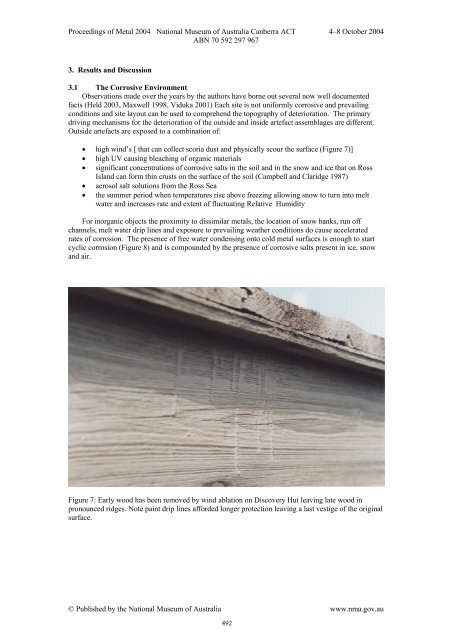Section 4: Composite artefacts (PDF 20858kb) - National Museum of ...
Section 4: Composite artefacts (PDF 20858kb) - National Museum of ...
Section 4: Composite artefacts (PDF 20858kb) - National Museum of ...
- No tags were found...
You also want an ePaper? Increase the reach of your titles
YUMPU automatically turns print PDFs into web optimized ePapers that Google loves.
Proceedings <strong>of</strong> Metal 2004 <strong>National</strong> <strong>Museum</strong> <strong>of</strong> Australia Canberra ACT 4–8 October 2004ABN 70 592 297 9673. Results and Discussion3.1 The Corrosive EnvironmentObservations made over the years by the authors have borne out several now well documentedfacts (Held 2003, Maxwell 1998, Viduka 2001) Each site is not uniformly corrosive and prevailingconditions and site layout can be used to comprehend the topography <strong>of</strong> deterioration. The primarydriving mechanisms for the deterioration <strong>of</strong> the outside and inside artefact assemblages are different.Outside <strong>artefacts</strong> are exposed to a combination <strong>of</strong>:• high wind’s [ that can collect scoria dust and physically scour the surface (Figure 7)]• high UV causing bleaching <strong>of</strong> organic materials• significant concentrations <strong>of</strong> corrosive salts in the soil and in the snow and ice that on RossIsland can form thin crusts on the surface <strong>of</strong> the soil (Campbell and Claridge 1987)• aerosol salt solutions from the Ross Sea• the summer period when temperatures rise above freezing allowing snow to turn into meltwater and increases rate and extent <strong>of</strong> fluctuating Relative HumidityFor inorganic objects the proximity to dissimilar metals, the location <strong>of</strong> snow banks, run <strong>of</strong>fchannels, melt water drip lines and exposure to prevailing weather conditions do cause acceleratedrates <strong>of</strong> corrosion. The presence <strong>of</strong> free water condensing onto cold metal surfaces is enough to startcyclic corrosion (Figure 8) and is compounded by the presence <strong>of</strong> corrosive salts present in ice, snowand air.Figure 7: Early wood has been removed by wind ablation on Discovery Hut leaving late wood inpronounced ridges. Note paint drip lines afforded longer protection leaving a last vestige <strong>of</strong> the originalsurface.© Published by the <strong>National</strong> <strong>Museum</strong> <strong>of</strong> Australia www.nma.gov.au492
















